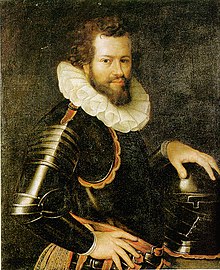Ranuccio I Farnese (28 March 1569 – 5 March 1622) reigned as Duke of Parma, Piacenza and Castro from 1592. A firm believer in absolute monarchy, Ranuccio, in 1594, centralised the administration of Parma and Piacenza, thus rescinding the nobles' hitherto vast prerogative.
This article needs additional citations for verification. (April 2021) |
| Ranuccio I | |
|---|---|
 | |
| Duke of Parma and Piacenza | |
| Reign | 3 December 1592 – 5 March 1622 |
| Predecessor | Alessandro |
| Successor | Odoardo |
| Born | 28 March 1569 Parma, Duchy of Parma and Piacenza |
| Died | 5 March 1622 (aged 52) Parma, Duchy of Parma and Piacenza |
| Burial | |
| Spouse | Margherita Aldobrandini |
| Issue | (illeg.) Prince Ottavio Odoardo, Duke of Parma Maria, Duchess of Modena and Reggio Vittoria, Duchess of Modena Cardinal Francesco Maria |
| House | Farnese |
| Father | Alexander Farnese, Duke of Parma |
| Mother | Maria of Portugal |
| Religion | Roman Catholicism |
Persecution of conspirators
Ranuccio was the son of Alexander Farnese, Duke of Parma and his wife, Infanta Maria of Portugal.[1] He is best remembered for the "Great Justice" of 1612, which saw the executions of a large number of Piacentine nobles suspected of plotting against him.[2] Claudia Colla his mistress and her mother were accused of using witchcraft to stop him from having offspring, and both were sentenced to death by burning.[3] Because one of the conspirators, Gianfrancesco Sanvitale, falsely implicated several Italian princes, namely Vincenzo Gonzaga, Duke of Mantua and Cesare d'Este, Duke of Modena, in the plot, Vincenzo and Cesare's names appeared on the list of conspirators during formal court proceedings; as a result, Ranuccio's reputation among the rulers of Italy was irreparably damaged because it was evident that he gave credence to Gianfrancesco's obviously false confession. When, consequently, in the early 1620s, Ranuccio was looking for a bride for his younger legitimate son and heir, Odoardo, none of the Italian ruling families were forthcoming with princesses.
Claim to the Portuguese throne
Ranuccio was engaged to Archduchess Catherine Renata of Austria in 1599 but the Archduchess died shortly after and he eventually married Margherita Aldobrandini,[4] niece of Pope Clement VIII a year later. As, the son of Maria of Portugal, was considered as a potential king of Portugal when his childless great-uncle King Henry died. The throne, however, passed to Philip II of Spain, whose troops had promptly occupied the country after King Henry's death.
His great-uncle King Henry's death triggered the struggle for the throne of Portugal when Ranuccio was 11 years old. As the son of the late eldest daughter of Duarte, Duke of Guimarães, the only son of King Manuel I whose legitimate descendants survived at that time, Ranuccio was according to the feudal custom, first in line to the throne of Portugal. However his father Alessandro Farnese, Duke of Parma was an ally of the Spanish king, another contender, so Ranuccio's rights were not claimed at the time. Instead, Ranuccio's maternal aunt Catarina, Duchess of Braganza, claimed the throne in an ambitious manner, but failed to become queen.
Annexation of new areas and patronage of the arts
Under Ranuccio I's rule, the dukedom annexed the territories of Colorno, Sala Baganza, and Montechiarugolo.[5] He guided a cultural renewal in the city of Parma, supporting the arts and constructing the 4,500 seat Farnese Theater. Numerous improvements and monuments in Parma were constructed under Ranuccio I at his behest, including a revitalization of the University of Parma and the final expansion of the city walls. Construction of the Palazzo della Pilotta, the court palace of the Farnese family, was completed in 1620.
Death and succession
Ranuccio was succeeded by his son Odoardo, initially under the regency of Ranuccio's brother, Odoardo Farnese.
Issue
Ranuccio married Donna Margarita Aldobrandini, daughter of Don Giovanni Francesco Aldobrandini, Prince of Carpineto (1545-1601) and his wife and the heiress, Donna Olimpia Aldobrandini, Princess of Meldola (1567-1637), on 7 May 1600 in Rome, St. Sixtus. The couple had nine children:
- Alessandro Francesco Maria Farnese (8 August 1602), died at birth.
- Maria Farnese (5 September 1603), died at birth.
- Alessandro Farnese (5 September 1610 – 24 July 1630), Hereditary Prince of Parma and Piacenza, deaf and mentally disabled from birth,[6] excluded from the succession.
- Odoardo Farnese, Duke of Parma (28 April 1612 – 11 September 1646),[6] married Margherita de' Medici and had issue.
- Orazio Farnese (7 July 1613 – 28 February 1614), died in infancy.
- Maria Farnese (18 February 1615 – 25 July 1646), married Francesco I d'Este, Duke of Modena[7]
- Maria Farnese (29 April 1618), died at birth.
- Vittoria Farnese (29 April 1618 – 10 Aug 1649), married Francesco I d'Este, Duke of Modena and had issue.
- Francesco Maria Farnese (19 August 1620 – 13 July 1647), Cardinal.
Before his marriage Ranuccio I had a relation with Briseide Ceretoli, who was at that time unmarried; she was the daughter of Ottavio Ceretoli, a colonel who had died in Flanders in the following of Alessandro Farnese, Duke of Parma. The couple had two natural children:
- (illeg.) Ottavio Farnese (1598–1643)
- Isabella Farnese, married Don Giulio Cesare Colonna, Prince of Palestrina and Carbognano (1602-1681)
References
Sources
Wikiwand in your browser!
Seamless Wikipedia browsing. On steroids.
Every time you click a link to Wikipedia, Wiktionary or Wikiquote in your browser's search results, it will show the modern Wikiwand interface.
Wikiwand extension is a five stars, simple, with minimum permission required to keep your browsing private, safe and transparent.
